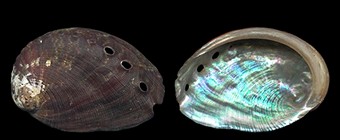 |
|
| ALMADIES (spot 1): |
In a discard pile, from a restaurant, Pointe des Almadies, Péninsule du Cap Vert, Dakar. 40mm.
The pop-up window shows also a huge specimen of 75mm. Notice the lagoon-blue of the nacre.
|
|
|
| | | |
 |
|
| ALMADIES (spot 1): |
Same pile. 66mm.
The main difference between these shells and specimens from Morocco is the size: chestnut abalones are smaller in the north (40-50mm), and thinner.
|
|
|
| | | |
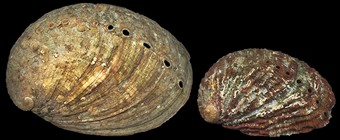 |
|
| REMEMBER: |
114 & 47mm. Brittany & Mediterranean.
The position of the apex, in shells of the form lamellosa as in brittanic specimens, is more excentred. These shells are totally ovato-oblongá, while chestnut abalones stay round-shaped.
|
|
| | | |
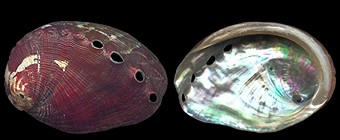 |
|
| ALMADIES (spot 1): |
Same pile. 51mm.
The dorsum shows many spiral cords, which are crossed by extremely weak transversal striae (transversis obsoletis)... The color changes a little, suddenly.
|
|
|
| | | |
 |
|
| ALMADIES (spot 1): |
Same pile, 56mm.
A patterned specimen, with large flat cords. The spiral sculpture is very dominant, as one can note on ventral side.
|
|
|
| | | |
 |
|
| ALMADIES (spot 1): |
At extreme low tide, on rocks. 36,5mm.
This one is a pure "lamellosa"! The size, the sculpture, the pattern are mediterranean, and we are in Senegal. Definitively different from the tuberculata's of western Morocco.
|
|
|
| | | |
 |
|
| ALMADIES (spot 1): |
At the same place, on the same rocks. 31-43mm.
Two marmorata with a fine sculpture. The shape, compared with
the shell above, is so different that it becomes quite difficult to
see in these page only one species.
|
|
|
| | | |
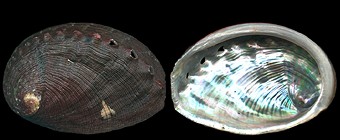 |
|
| M'BOUR (spot 2): |
At low tide, on rocks. 64mm.
Again the african brown. This population of Sénégal
is quite homogeneous, and does not show significative diffrences with
the chestnut abalones from Morocco.
|
|
|
| | | |
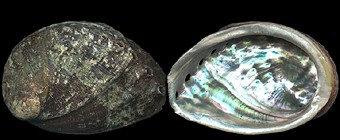 |
|
| M'BOUR (spot 2): |
At low tide, on rocks. 72mm.
The general shape does not vary a lot.
H. tuberculata is more inventive.
|
|
|
| | | |
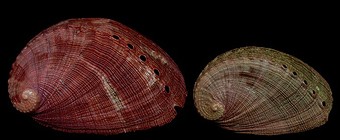 |
|
| REMEMBER: |
Two H. tuberculata from SW. Morocco.
Quite different from the above shells. But compare them with the specimens below.
|
|
| | | |
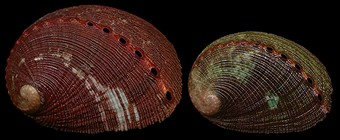 |
|
| NZEMA CAPE (spot 3): |
5-6m deep, under stones. 26-34mm.
These shells from Cape 3 Points, Ghana, are surprisingly close to the shells pictured above.
But the shape, the position of the apex, remain those of marmorata. This form is named guineensis Gmelin.
|
|
|
| | | |
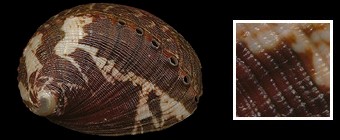 |
|
| TAKORADI (spot 4): |
8-10m deep, under rocks. 57mm.
Again the chestnut design, but with this odd scaly sculpture, much more apparent than on the Senegalese specimens. We understand why Philippi proposed the epithet decussata (now syn. of rosacea Reeve, itself syn. of marmorata)...
|
|
|
| | | |
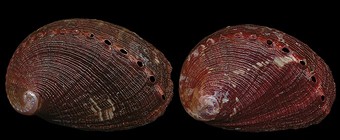 |
|
| SÃO TOMÉ (spot 5): |
3-5m deep, under rocks. 34-41mm.
As you can see, surprises are not finished. These shells are more slender than Senegalese marmorata's. The shape is of a tuberculata, but the sculpture is very decussata, the whole shell is rosacea.
|
|
|
| | | |
 |
|
| SÃO TOMÉ (spot 5): |
12-20m deep, on rocks. 24mm.
Terrific. No more decussate sculpture, but the "tuberculata" shape is here. A local variant of the variant?
|
|
|
 Haliotis rosacea. Hal. testâ ovatâ, convexo-depressâ, spiraliter crebriliratâ, liris striis exsculptis undique decussatis ;
foraminibus peculiariter oblongo-ovatis, quaternis perviis ; extus corallo-rubro et roseo-albicante marmorat‚, rubro viridi punctatâ. Haliotis rosacea. Hal. testâ ovatâ, convexo-depressâ, spiraliter crebriliratâ, liris striis exsculptis undique decussatis ;
foraminibus peculiariter oblongo-ovatis, quaternis perviis ; extus corallo-rubro et roseo-albicante marmorat‚, rubro viridi punctatâ. (src: BioSophia archive BA00000065)
 The rose-tinted Haliotis. Shell ovate, convexly depressed, spirally closely ridged, decussated throughout with engraved striae;
perforations peculiarly oblong ovate, four open; exterior marbled with deep coral red punctured with green (Reeve L.A., Proceedings of the Zoological Society, 1846). |
 |
 "It is impossible to give any other than a very faint conception of this beautiful shell in a figure,
the entire surface has a most delicate beaded appearance, and the colouring is extremely rich; there is also a marked peculiarity in the oblong shape of the perforations which very nearly approximate." |
 [next: Comparative table] [next: Comparative table] |
















